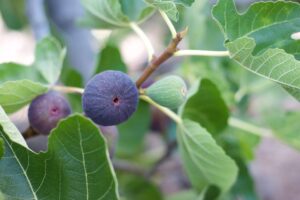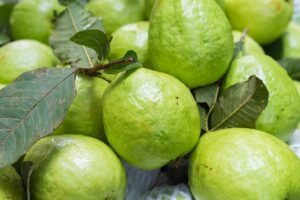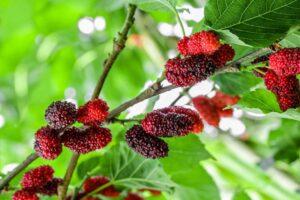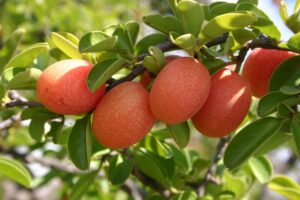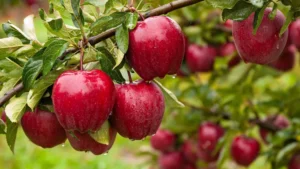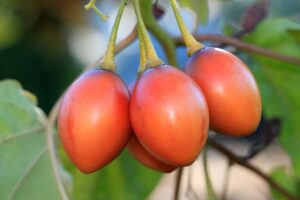How to Grow and Care for Bananas: A Complete Guide
Are you dreaming of growing your own tropical paradise with fresh, homegrown bananas? Whether you have a spacious garden, a cozy patio, or even just a sunny indoor spot, you can successfully grow banana plants with the right knowledge and care. This comprehensive guide will walk you through everything you need to know about growing bananas in different environments across the US.
Understanding Banana Plants
Banana plants (Musa spp.) are often mistaken for trees, but they’re actually large herbaceous plants. What appears to be a trunk is actually a pseudostem made of tightly packed leaf sheaths. Native to tropical regions of Southeast Asia, bananas have been cultivated for thousands of years and are now grown in many parts of the world, including certain regions of the United States.
According to the USDA Agricultural Research Service, bananas are the fourth most important food crop globally after rice, wheat, and corn. In the US, commercial banana production is primarily limited to Hawaii, Puerto Rico, and parts of Florida, but home gardeners in many states can grow them as ornamental plants or for fruit with proper protection.
Banana Varieties Suitable for US Growing
Not all banana varieties will thrive in US climates. Here are some varieties that home gardeners in the US can consider:
Cold-hardy varieties:
- Musa basjoo (Japanese Fiber Banana) – Ornamental, can survive temperatures down to 15°F (-9°C) with protection
- Musa ‘Orinoco’ (Horse Banana) – More cold-tolerant than most fruiting varieties
- Musa ‘Raja Puri’ – Compact variety good for containers, somewhat cold-tolerant
Dwarf varieties for containers:
- ‘Dwarf Cavendish’ – Grows 4-7 feet tall, good for indoor or container growing
- ‘Dwarf Brazilian’ – Compact fruiting variety
- ‘Gran Nain’ – Commercial variety that stays relatively small
Banana Growing Conditions
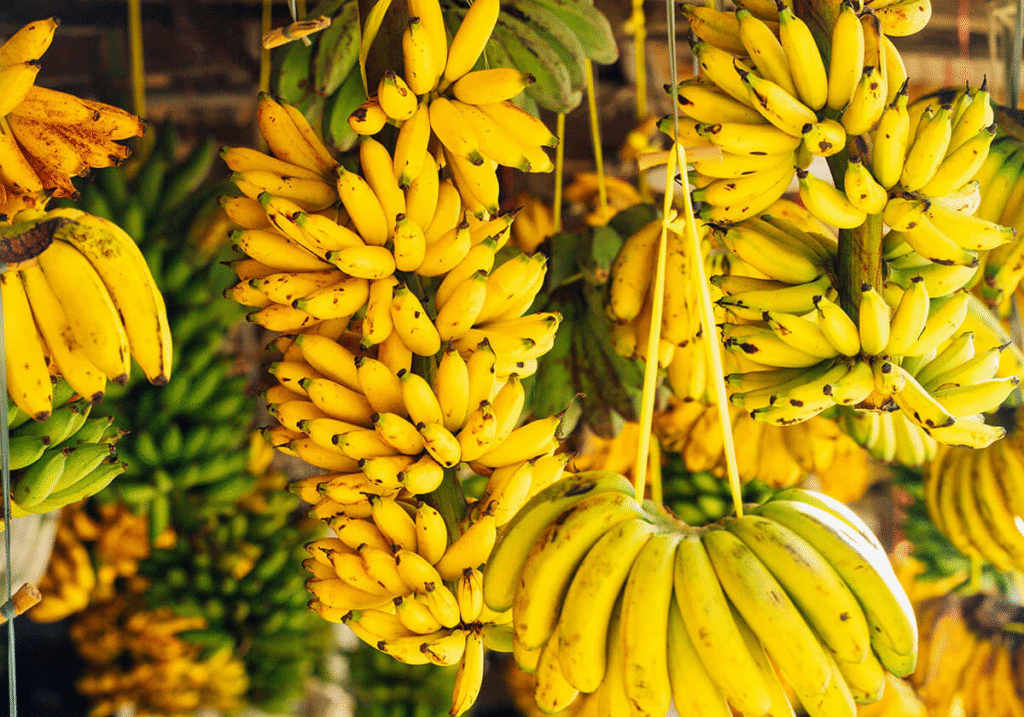
Climate Requirements
Bananas are tropical plants that thrive in warm, humid conditions. They grow best in USDA zones 9-11, though some cold-hardy varieties can survive in zone 8 with winter protection. According to the USDA Plant Hardiness Zone Map, these conditions are found naturally in:
- Hawaii
- Southern Florida
- Parts of California
- Southern Texas
- Puerto Rico
If you live outside these regions, don’t worry! You can still grow bananas in containers that can be moved indoors during colder months or as ornamental plants.
Soil and Light Requirements
Bananas need:
- Rich, well-draining soil with plenty of organic matter
- pH between 5.5-7.0
- Full sun (at least 6 hours of direct sunlight daily)
- Protection from strong winds that can damage large leaves
Growing Bananas from Seed
Growing bananas from seed is uncommon and challenging, as most edible banana varieties are sterile hybrids that don’t produce viable seeds. The bananas we typically eat are parthenocarpic (developing without fertilization) and seedless. However, if you’re interested in the challenge or want to grow ornamental varieties, here’s how:
- Obtain fresh seeds: Look for specialty nurseries or online sources that sell banana seeds. Most commercial bananas don’t contain viable seeds.
- Scarify the seeds: Banana seeds have hard coats. Gently file or nick the seed coat to help with germination.
- Soak the seeds: Place them in warm water for 24-48 hours to soften the seed coat further.
- Prepare germination medium: Use a mix of peat moss and perlite or a seed-starting mix.
- Plant seeds: Bury them 1/4 inch deep in the medium.
- Maintain warm, humid conditions: Keep the temperature between 75-85°F (24-29°C) and maintain high humidity.
- Wait patiently: Germination can take anywhere from 3 weeks to 6 months.
Propagating Bananas from Pups (Suckers)
The most common and reliable method for propagating bananas is through pups or suckers, which are offshoots that develop from the rhizome of the mother plant.
- Select a healthy pup: Look for a pup that’s 2-3 feet tall with narrow leaves (sword suckers) rather than wide leaves (water suckers).
- Separate from the mother plant: Using a sharp, clean spade, cut the pup away from the mother plant, ensuring you get some roots attached.
- Prepare the pup: Remove any excess soil and trim damaged roots or leaves.
- Allow cut surfaces to dry: Let the cut surfaces callus for a day before planting.
- Plant in prepared soil: Place in well-draining, rich soil with the base about 4-6 inches deep.
Growing Bananas in Containers
Container growing is perfect for areas with cold winters or limited space. The USDA’s Urban Agriculture Toolkit provides guidance on container gardening that can be applied to bananas.
Choosing the Right Container
- Start with a 5-10 gallon pot for young plants
- Move to a 15-30 gallon container as the plant grows
- Ensure adequate drainage holes
- Choose a sturdy material (plastic, ceramic, or fabric grow bags)
Container Growing Steps
- Fill with proper medium: Use a mix of potting soil, compost, and perlite for good drainage and nutrition.
- Plant at the right depth: The rhizome should be about 4 inches below the soil surface.
- Place in a warm, sunny location: Provide at least 6 hours of sunlight daily.
- Water thoroughly: Keep soil consistently moist but not waterlogged.
- Feed regularly: Apply balanced fertilizer monthly during growing season.
- Protect during winter: Move containers indoors or to a protected area when temperatures drop below 50°F (10°C).
Growing Bananas in the Garden
If you live in a suitable climate (USDA zones 9-11), you can grow bananas directly in your garden.
Garden Planting Steps
- Choose a sheltered location: Find a spot protected from strong winds with full sun exposure.
- Prepare the soil: Incorporate plenty of compost and organic matter into the planting area.
- Dig an appropriate hole: Make it twice as wide as the root ball and at the same depth.
- Space properly: Plant bananas 6-10 feet apart, depending on the variety.
- Water deeply: Keep soil consistently moist, especially during the growing season.
- Mulch heavily: Apply 3-4 inches of mulch around the plant, keeping it away from the pseudostem.
Banana Plant Care Guide
Watering
Bananas are water-loving plants with large leaves that transpire moisture rapidly. Proper watering is essential:
- Keep soil consistently moist but not waterlogged
- Water deeply when the top 1-2 inches of soil feels dry
- Reduce watering slightly during winter dormancy
- Increase watering during hot, dry periods
Fertilization
Bananas are heavy feeders requiring regular fertilization:
- Apply balanced fertilizer (like 8-10-8) monthly during growing season
- Use organic options like compost, well-rotted manure, or fish emulsion
- Consider adding potassium and magnesium for better fruiting
- Reduce fertilization during winter months
Temperature Management
| Temperature Range | Effect on Banana Plants | Action Required |
|---|---|---|
| Above 100°F (38°C) | Heat stress, leaf burn | Provide shade, increase watering |
| 80-95°F (27-35°C) | Optimal growth | Regular care |
| 55-80°F (13-27°C) | Slower growth | Normal care, may need less water |
| 32-55°F (0-13°C) | Growth stops | Reduce watering, protect if outdoors |
| Below 32°F (0°C) | Leaf damage, possible death | Move indoors or provide complete protection |
Pest and Disease Management
Bananas can be affected by various pests and diseases. The USDA Agricultural Research Service provides detailed information on identifying and treating these issues.
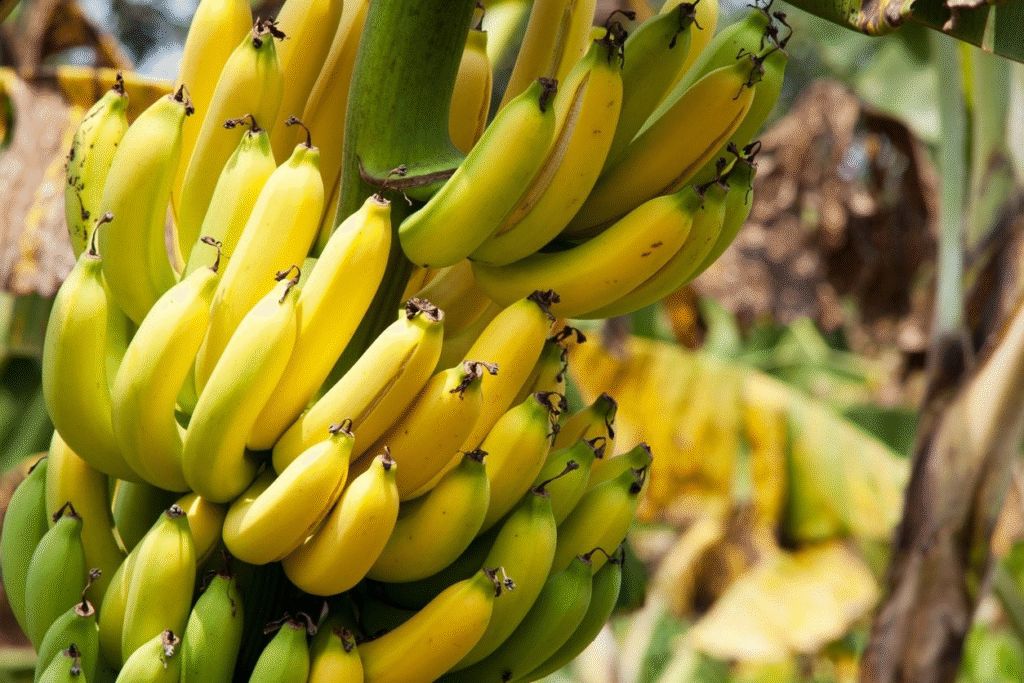
Common pests:
- Banana aphids
- Spider mites
- Thrips
- Nematodes
Common diseases:
- Panama disease (Fusarium wilt)
- Black Sigatoka
- Banana bunchy top virus
- Bacterial wilt
Management strategies:
- Inspect plants regularly for signs of pests or disease
- Maintain good air circulation
- Avoid overhead watering
- Remove and destroy infected plant material
- Use organic or chemical controls as appropriate
Harvesting Bananas
If you’re fortunate enough to have your banana plant produce fruit, here’s what to know about harvesting:
- Timing: Bananas are harvested when they’re mature but still green. This typically occurs 80-180 days after flowering, depending on the variety.
- Harvesting method: Cut the entire stem (called a “hand”) when the fruits are full-sized but still green.
- Ripening: Allow bananas to ripen at room temperature. They’ll gradually turn yellow and develop sweetness.
- Post-harvest care: After harvesting, cut down the fruiting pseudostem as it won’t produce again. New suckers will emerge to produce the next crop.
Winterizing Banana Plants
In areas with cold winters (zones 8 and below), you’ll need to protect your banana plants:
Container Plants
- Before first frost, move containers indoors to a bright location
- Reduce watering during winter dormancy
- Monitor for pests that thrive in indoor conditions
- Gradually reintroduce to outdoor conditions in spring
Garden Plants
- Cut back the plant to about 4-6 feet tall after the first light frost
- Create a protective cage around the trunk using chicken wire
- Fill the cage with straw, dry leaves, or other insulating material
- Cover the top with plastic to keep moisture out
- Remove protection in spring when danger of frost has passed
Common Banana Growing Challenges and Solutions

Not Producing Fruit
- Problem: Your banana plant grows well but doesn’t produce fruit.
- Solution: Ensure adequate sunlight, proper fertilization with potassium, and sufficient growing time (bananas need 10-24 months to fruit depending on variety).
Yellowing Leaves
- Problem: Leaves turning yellow prematurely.
- Solution: Check for overwatering or poor drainage. Could also indicate nutrient deficiencies, particularly nitrogen or magnesium.
Cold Damage
- Problem: Leaves blacken and die after cold exposure.
- Solution: Cut damaged leaves, protect the pseudostem and rhizome, and wait for new growth in spring.
Pest Infestations
- Problem: Spider mites or aphids causing leaf damage.
- Solution: Treat with insecticidal soap or neem oil, increase humidity around plants.
Growing Bananas for the US Market
While commercial banana production in the continental US is limited by climate, small-scale growers in suitable regions can supply local markets:
- Find your niche: Focus on specialty varieties not commonly found in grocery stores
- Research local regulations: Check with your state’s Department of Agriculture about any certification requirements
- Explore direct marketing: Consider farmers’ markets, CSAs, or supplying to local restaurants
- Value-added products: Consider making banana chips, dried bananas, or baked goods
Conclusion
With proper care and attention to their specific needs, banana plants can be a rewarding addition to your garden or home. In suitable climates, you might enjoy your own homegrown fruit. Even in cooler regions, they make dramatic ornamental plants that bring a tropical feel to your space.
Remember that patience is key with banana cultivation. These plants take time to establish and produce fruit, but the process of growing them is as rewarding as the harvest. By following the guidelines in this article, you’ll be well on your way to creating your own banana paradise, whether it’s in your garden, on your patio, or indoors.
For more information on tropical fruit cultivation, visit the USDA Tropical Plant Genetic Resources and Disease Research website.

